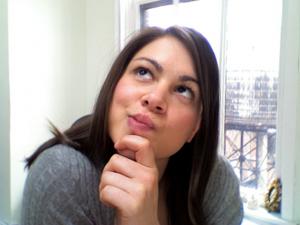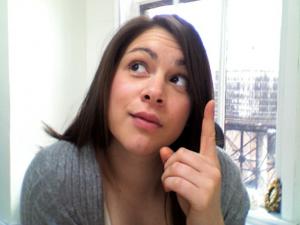Serendip is an independent site partnering with faculty at multiple colleges and universities around the world. Happy exploring!
On symbolic evolution
Towards Day 12 of Evolving Systems course
 |
 |
 |
 |
I. welcoming Emily Artz French Kenny!
II. coursekeeping
* break! no papers for TWO WEEKS! but read those novels!
* on Monday evening when you return, please post on-line your responses to Renfrow's essay and the conversation we're about to have w/ Emily: how predictable is cultural change? what role do the physical and biological environment and individual choice play in cultural change?
III. Renfrow's Prehistory
Chapter 5, "The Sapient Paradox":
huge gap between first appearance of homo sapiens and earliest agricultural revolution:
new inherent genetic capacity w/out rapidly visible effects
human revolution took place in Africa 150,000-70,000 years ago
dispersal "out of Africa" 60,000 years ago, with language capacity;
why the delay in modern human behaviors?
genetic and cultural co-evolution during the speciation phase,
but most impressive human developments came after, during tectonic phrase:
momentum of constructing human culture came from learned, not inherited, behaviors
Chapter 6, "Towards a Prehistory of Mind":
laws of genetics don't govern cultural transmission
("memes" a misguided = simplistic concept)
cognitive archeology studies us as symbol-making animals:
what we think with, involving two radical procedures of abstraction:
formation of categories, and processes of representation
"brute facts"--> "social facts" --> "institutional facts"
X (symbol/signifier) represents Y (thing signified) in context C;
relation between X and Y is arbitrary, dependent on social relations
(evolution of belief in the supernatural)
Merlin Donald's unilineal stages in cultural development
=kinds of cognitive activity
1. episodic (reactive to stimulus)
2. mimetic (early tools, nonverbal communication, shared attention)
3. mythic (homo sapiens: complex language, narrative thought)
4. material symbolic (material good have symbolic importance)
5. theoretic ("institutionalised paradigmatic thought" and external memory storage=writing, 3500 B.C.)
defining symbols requires recognizing new material features of the world (ex: weights, arbitrary values, perceived, then conceptualized)
extended and distributed mind play active role
development of sedentism brought new processes of material engagement into play:
dependent on social contexts, roles, relationships, conventions, contracts, understandings
no one generalized story of human progress;
independent innovations include languages (which are hard to trace)
IV. pretty good framing for the conversation we're about it have; one question Renfrew's book puts on the table (again) is about the role of individual creativity in cultural change; another is about pacing (what Steven Jay Gould called "punctuated equilibrium"--what's happening when "nothing seems to be happening"?)
Let's start talking about this
w/ reference to Emily's series, An Evolution
the catalyst for the series was Awareness:

Creativity is about "failure" (an experiment of the unknown)
and "lack" (need forces us to become resourceful, to innovate).
"Ideas" exist in a vast, immensely intertwined network;
individuals can aggregate and organize them in a new ways:
"the way I 'evolve' the idea is just as valuable as if I had the original idea myself."
Art is the continuous effort to expose the
infinite number of perspectives in this world:
an Evolutionary process of Compassion and Understanding.
Designing is much more deliberate (subject to
societal and cultural needs), a means to an end;
Art-making is exploratory, an end in itself, a journey to be enjoyed.
These provoke different brain processes:
being scrutinized, vs. joyfully exploring.
3 elements creativity relies on:
that one is a powerful creative being and deserves to be self-expressive


